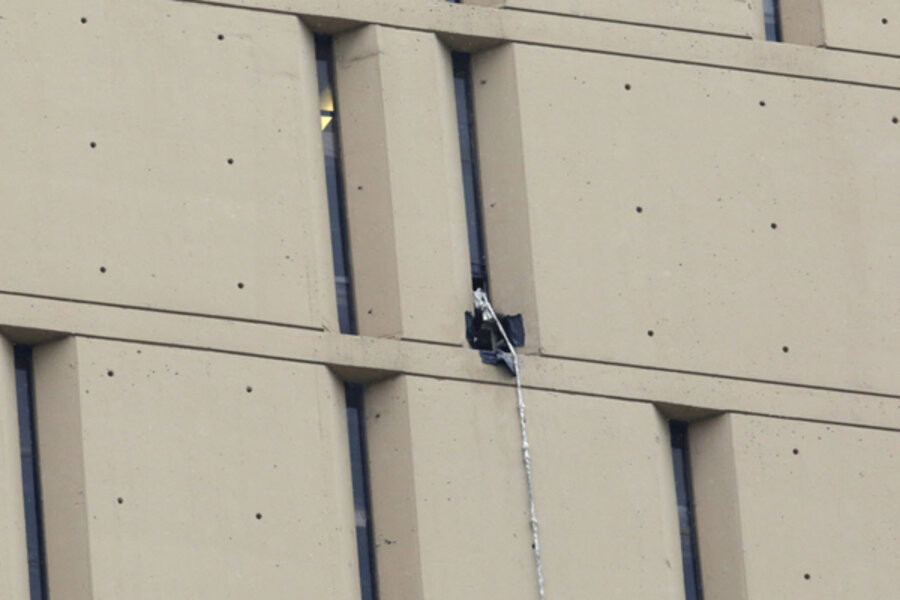Escape down high-rise jail has Chicago wondering: how'd they dare?
| Chicago
A death-defying escape by two inmates from a high-rise federal prison in downtown Chicago has law enforcement officers, prison officials, and the general public scratching their heads in wonder at how they managed to pull it off without being caught, and that they dared to do it at all.
Joseph Banks and Kenneth Conley, two convicted bank robbers imprisoned on separate charges, seemingly vanished early Tuesday morning after they apparently rappelled down 15 stories of the Metropolitan Correctional Center, a high-rise federal detention facility, in the middle of the night on a knotted chain of bed sheets secured to the bars of their prison cell.
Prison officials say the pair, recent cellmates not known to have had a previous relationship, somehow slipped through a five-inch wide window to make the escape, raising speculation they may have removed a cinder block to widen the opening.
Before prison officials pulled the knotted sheets back into the cell on Tuesday, the spectacle of the thin rope dangling down the sheer side of the prison from 15 floors up drew gapes and gasps of astonishment from passersby. It was only the second escape ever from the 37-year-old Chicago facility, and the first since the 1980s
Last seen in their cell at 10 p.m. Monday, the pair’s absence was not discovered until nine hours later. They escaped notice by stuffing their beds with clothing to appear they were sleeping throughout the night.
The FBI, which said Wednesday the pair was seen getting into a taxi at 2:45 a.m. Tuesday, is offering a $50,000 reward for information that leads to their capture. So far, the FBI says it has no leads on their whereabouts, though it was focusing the search Wednesday on the Chicago area. The two men are considered dangerous.
While escapes from prison often can capture the public’s imagination, in reality few are successful, says John Paitakes, a criminal justice professor at Seton Hall University in South Orange, N.J., and a former member of the New Jersey State Parole Board. While all inmates usually fantasize about escaping, he says, those that make the attempt are typically facing long prison terms, or need to confront or resolve a personal issue involving a family member, spouse, or significant other.
Mr. Banks, known as the Second-Hand Bandit for wearing thrift-store clothes while carrying out his robberies, was convicted last week on multiple bank robbery counts related to a prolific string of robberies that took place around the Chicago area in 2007 and 2008, while Mr. Conley pled guilty to a single bank robbery in 2011 and was awaiting sentencing Jan. 10. Banks was facing a maximum 80-year sentence, Conley a 20-year sentence.
Prison breaks have long been the stuff of television shows and movies, such as “Escape from Alcatraz,” “The Rock,” “The Fugitive” and, naturally, “Prison Break,” the FOX drama. Because most prison escapees are caught, those who elude capture tend to earn a degree of infamy, such as John Dillinger’s 1933 escape from an Indiana jail using a gun made out of soap, and the notorious 1962 escape by Frank Morris and brothers John and Clarence Anglin from Alcatraz Island in San Francisco Bay.
More recently, in 2007, Greek criminal Vassilis Palaiokostas escaped from a maximum-security prison in Korydallos, Greece, via a helicopter that landed on the prison roof. Mr. Palaiokostas is particularly infamous since it was the second time in three years he broke out of the prison via a hijacked helicopter. He is still at large.
Tod Burke, a criminal justice professor at Radford University in Radford, Va., says cases like those often fuel prisoners who may consider taking the risk.
“It probably goes through every person’s mind who’s in there at some point, making them think, ‘where are the vulnerabilities of the prison, could I escape, should I escape.’ But people will say it’s not worth it,” Professor Burke says.
Because both men used firearms in their robberies, they are considered dangerous, officials say. They are also considered well financed: Banks stole as much as $600,000, and only about $80,000 has been recovered.
Paitakes says that, to the public, both men should not be considered folk heroes for pulling off such a daring escape because “they have nothing to lose.”
“They don’t want to be caught,” he says, “so they’ll do some dangerous things like car jacking, maybe murder, because they know what will probably happen if they are caught – solitary confinement, which can be even worse” than their original sentencing terms.
Any investigation by the US Bureau of Prisons, which operates the high-rise prison, into how the men were allowed to escape, is expected to shape future detention policies.
“This goes beyond this one incident. This will have a trickle-down effect upon policies, not only in Chicago, but nationwide and also worldwide,” Burke says. “People are going to be looking at this and asking questions for a long time.”






